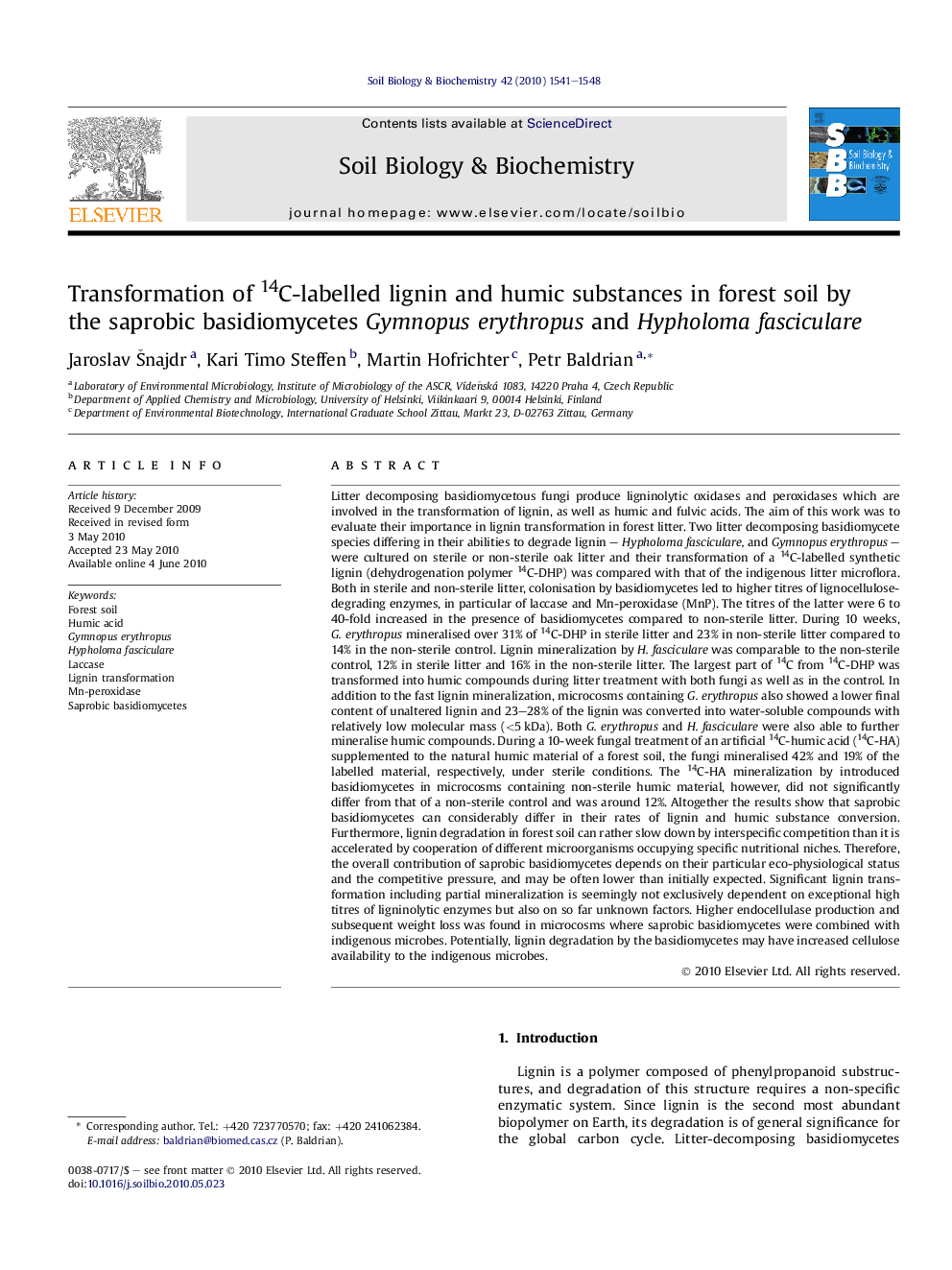| کد مقاله | کد نشریه | سال انتشار | مقاله انگلیسی | نسخه تمام متن |
|---|---|---|---|---|
| 10846123 | 1070002 | 2010 | 8 صفحه PDF | دانلود رایگان |
عنوان انگلیسی مقاله ISI
Transformation of 14C-labelled lignin and humic substances in forest soil by the saprobic basidiomycetes Gymnopus erythropus and Hypholoma fasciculare
دانلود مقاله + سفارش ترجمه
دانلود مقاله ISI انگلیسی
رایگان برای ایرانیان
کلمات کلیدی
موضوعات مرتبط
علوم زیستی و بیوفناوری
علوم کشاورزی و بیولوژیک
دانش خاک شناسی
پیش نمایش صفحه اول مقاله

چکیده انگلیسی
Litter decomposing basidiomycetous fungi produce ligninolytic oxidases and peroxidases which are involved in the transformation of lignin, as well as humic and fulvic acids. The aim of this work was to evaluate their importance in lignin transformation in forest litter. Two litter decomposing basidiomycete species differing in their abilities to degrade lignin - Hypholoma fasciculare, and Gymnopus erythropus - were cultured on sterile or non-sterile oak litter and their transformation of a 14C-labelled synthetic lignin (dehydrogenation polymer 14C-DHP) was compared with that of the indigenous litter microflora. Both in sterile and non-sterile litter, colonisation by basidiomycetes led to higher titres of lignocellulose-degrading enzymes, in particular of laccase and Mn-peroxidase (MnP). The titres of the latter were 6 to 40-fold increased in the presence of basidiomycetes compared to non-sterile litter. During 10 weeks, G. erythropus mineralised over 31% of 14C-DHP in sterile litter and 23% in non-sterile litter compared to 14% in the non-sterile control. Lignin mineralization by H. fasciculare was comparable to the non-sterile control, 12% in sterile litter and 16% in the non-sterile litter. The largest part of 14C from 14C-DHP was transformed into humic compounds during litter treatment with both fungi as well as in the control. In addition to the fast lignin mineralization, microcosms containing G. erythropus also showed a lower final content of unaltered lignin and 23-28% of the lignin was converted into water-soluble compounds with relatively low molecular mass (<5 kDa). Both G. erythropus and H. fasciculare were also able to further mineralise humic compounds. During a 10-week fungal treatment of an artificial 14C-humic acid (14C-HA) supplemented to the natural humic material of a forest soil, the fungi mineralised 42% and 19% of the labelled material, respectively, under sterile conditions. The 14C-HA mineralization by introduced basidiomycetes in microcosms containing non-sterile humic material, however, did not significantly differ from that of a non-sterile control and was around 12%. Altogether the results show that saprobic basidiomycetes can considerably differ in their rates of lignin and humic substance conversion. Furthermore, lignin degradation in forest soil can rather slow down by interspecific competition than it is accelerated by cooperation of different microorganisms occupying specific nutritional niches. Therefore, the overall contribution of saprobic basidiomycetes depends on their particular eco-physiological status and the competitive pressure, and may be often lower than initially expected. Significant lignin transformation including partial mineralization is seemingly not exclusively dependent on exceptional high titres of ligninolytic enzymes but also on so far unknown factors. Higher endocellulase production and subsequent weight loss was found in microcosms where saprobic basidiomycetes were combined with indigenous microbes. Potentially, lignin degradation by the basidiomycetes may have increased cellulose availability to the indigenous microbes.
ناشر
Database: Elsevier - ScienceDirect (ساینس دایرکت)
Journal: Soil Biology and Biochemistry - Volume 42, Issue 9, September 2010, Pages 1541-1548
Journal: Soil Biology and Biochemistry - Volume 42, Issue 9, September 2010, Pages 1541-1548
نویسندگان
Jaroslav Å najdr, Kari Timo Steffen, Martin Hofrichter, Petr Baldrian,